Liu Gen Buddhist Stele depicts the scene of the Buddha Sakyamuni expounding the Law at Sanarth. However, such a lively scene was not represented through the conventional relief technique of the Northern Wei Dynasty but rather by the incised line carving by lowering the ground that was a traditional Chinese technique, making it a perfect poster for propagandizing the Buddhism doctrine. These line carved designs were created by experienced artisans with sharp carving knives on smooth stone surfaces, which, unlike plain line-drawing or engraving in relief, was a unique form of art in traditional Chinese artworks. They have been found in a large number from Wuliang Shrine of Jiaxiang, Shandong Province, and tombs of the Han Dynasty at Dahuting in Mi County, Henan Province. In the Southern and Northern Dynasties, stone carvings combined with the Buddhist art with innovations in carving techniques.
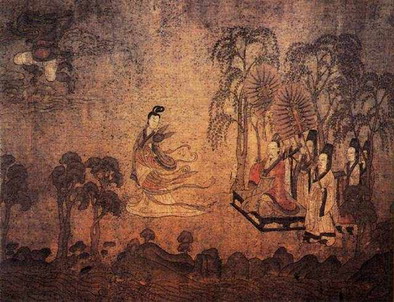
Part of the Painting Ode to the Goddess of the Luo River by Gu Kaizhi
Liu Gen Buddhist Stele was created with the technique of incised line carving by lowering the ground, following the artistic tradition in the production of stone reliefs of the Han Dynasty. The Gaogu Yousi method (floating silk threads from antiquity) was adopted on the details after the outline was carved, displaying the character of human figures and different layers of the image with soft and fluent lines. The Bodhisattvas are similar to human figures in Ode to the Goddess of the Luo River painted by Gu Kaizhi in terms of the image and the wrinkles of the clothes. Therefore, it is safe to say that Liu Gen Buddhist Stele is a very valuable and rare masterpiece that perfectly combines the technique of drawing and stone carving.
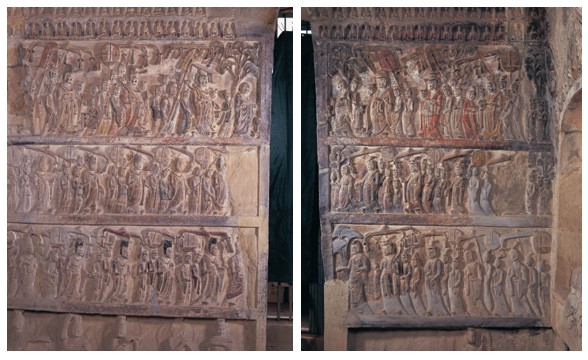
Liu Gen Buddhist Stele is not only a statue with fine line carving but also a delicately carved calligraphic masterpiece that features neat, dense, and naturally graceful strokes. It is likely to be written by an official-scholar. After moving its capital to Luoyang, the Northern Wei Dynasty completely absorbed the Han cultural system in the Central Plains that contributed to the development in its economy and culture.
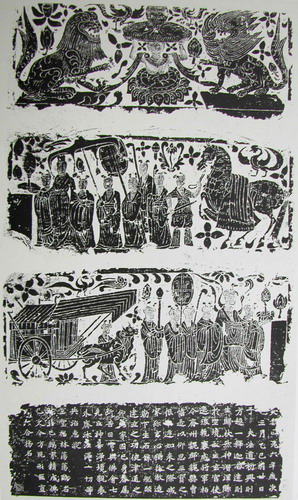
The Zhengguang period of the Northern Wei Dynasty saw flourishing development: the Buddhism became widely popular; donors of statues were pious and generous; sculptors were dedicated and skillful. As a result, the statues made in this period were highly achieved in both painting and calligraphy. The statues featured lifelike expression; human figures were exquisitely carved; characters were written in a stately, rigorous and forceful style, similar to that of other tombstone inscriptions of the Northern Wei Dynasty such as the one of Yuan Mi dating back to the fifth year of Zhengguang period. The characters demonstrate a square or slightly flat structure. The horizontal lines are straight and leveled and the strokes of “pie” and “na” are extended and stretched just like strong hands and feet that are unfolding to provide stable support. The characters of “口” and “冂” that are of the embracing structure are usually in a perfect square or rectangular shape, demonstrating a plump and magnificent posture. The brushstrokes retain characteristics of the official script in the Han Dynasty that start against the flow with the head hidden and the end protected. Meanwhile, they audaciously show the initial tip of the brushwork to establish the imposing and bold momentum. Therefore, Liu Gen Buddhist Stele is unarguably another calligraphic masterpiece of Weibei style in addition to “Twenty Works of Calligraphy from Longmen”. In 1916, Li Henong made a rubbing, from which most of the reproductions currently in circulation are copied. In addition to the reduced artistic conception, the rubbing is shorter than the original stone by three cun and the two broken characters of “Dong Zhen” on the very left line are not present in the rubbing.
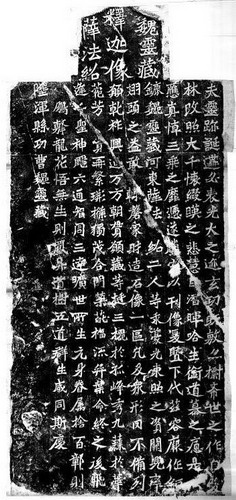
Wei Lingzang Narratives of the Twenty Works of Calligraphy from Longmen
The donors mentioned in the inscription include prestigious people in the Northern Wei Dynasty who were recorded in the Book of Wei. Hou Gang, for example, whose biography can be found in Volume 93 of the Book of Wei, died in the second year of Xiaochang period (526A.D). The “Tombstone Inscription of Duke of Wuyang, Palace Attendant and General of Chariots and Cavalry (the rank equal to the three councillors) of the Wei Dynasty” unearthed in Luoyang had detailed record about the life of Hou Gang, which corresponds with the Liu Gen Statue inscription.
Qifu Bao’s brief biography was included in Volume 86 of the Book of Wei. The “tombstone inscription for Duke Qifu of Ningboguo, Former Envoy, Military Governor, Military Supervisor of Hezhou and Liangzhou Prefectures, General-in-Chief who Guards the Military and Governor of Hezhou Prefecture of the Wei Dynasty” made in the second year of Yongxi period(533 A.D)of the Northern Wei Dynasty and unearthed in Bailuzhuang village of Luoyang in 1928 has detailed record of his life. The tomb inscription roughly corresponds with that on the Liu Gen Statue Tablet with the exception of title “Lingxizuoling(领细作令)” that was mentioned on the stele but not in the biography or tombstone inscription. The Book of Wei • Official Titles has “Jiangzuodajiang” but not the “Lingxizuoling(领细作令)”. It is likely to be an alias of the “Jiangzuodajiang”. The Southern Dynasties has the official post of “Xizuoling(细作令)” while the Northern Qi and Sui Dynasties had “Xizuoshuling(细作署令)”, which were both officials in charge of managing engineering constructions.
Yuan Yan, son of Xin Cheng who was Prince of Yangping, had his biography in Volume 19 of the Book of Wei that reads: “Yan who was brother of Yi, styled An Le, was granted the rank of Marquis of Guangling and assumed the official position of governor of Liangzhou Prefecture”. It did not mention “General Wuwei or Jingmingsi Dujiang”, but the gap may be filled by the stele inscription.
As a result of implementing the policy of sinicization by Emperor Xiaowen of the Northern Wei Dynasty, cultures of the Central Plains and the Southern Dynasties heavily influenced the Buddhist steles made during the Zhengguang period. The forceful, bold and unconstrained style,round and plump face once dominated the northwest region in the early stage of statue making were replaced by the delicate ones. The half covered cassock and through-the-shoulder coat in the Indian and Gandhara style started to be replaced by cassocks with national characteristics, i.e., ample gown and loose girdle, and the wrinkles of the clothes changed from delicate and complicated style popular in the Western Regions to the lively and flowing terracing style.
Liu Gen Buddhist Stele shows that the stele-producing during Zhengguang period gradually transited from the morbid “skinny” style to the healthy “elegant” one. They had a more elegant body and a well-proportioned design. The face gradually demonstrated the slightly long but mainly squarely round style, the belly bulged slightly outward, and the triangular sloping shoulders were gradually replaced by plump and round ones. The clothes became wide and broad with more overlapped and dense folds. These steles were not only popular in Luoyang, capital of the Northern Wei Dynasty, and the nearby regions, but also exerted a great influence on the entire northern region. Therefore, they were favored by all ethnic groups in China. Such a transition in style is evident in Liu Gen Buddhist Stele, reflecting the change in the artistic style of China’s Buddhist statues from those influenced by Gandhara to those demonstrating the secular and national characteristics in China.
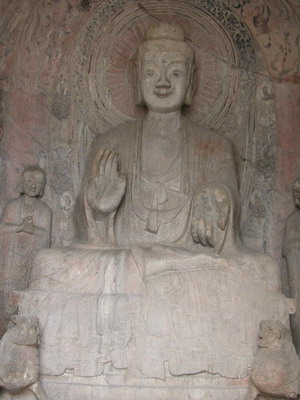
The Buddhist Votive Stele Commissioned By Liu Gen consists of three parts of carving. The center features line carved design of Buddha Expounding the Law, flanked by the characters of “Fo Di Zi Liu Gen Si Yi Ren Deng Jing Zao Xing Ji” (respectively built by Liu Gen and other Buddha’s disciples totaling 41 people) and the name of the artisan. The Buddha with a delicate face wears a high inner chignon and a dropping double-collared through-the-shoulder coat with a Buddhist undergarment inside. On the chest is a knot and the right piece of the coat is pulled to the left arm and hangs loosely after being wrapped around the elbow. Meanwhile, the hand makes a law-expounding gesture. The Buddha sits with crossed legs on top of a square sumeru pedestal that has a tightened belly. The right foot is exposed and the upper part of the sumeru pedestal is covered by the edge of the skirt. The lotus petal-shaped aureole of flames connects with halos around the head and the body. The upper-part canopy is decorated with carved designs of banana leaf, lotus flower, lotus petals, and triangular hanging beads. The four bands hang down behind the halo. Two Danapati Bodhisattvas are carved on both sides in front of Sakyamuni. Each has a flower chignon on the head and a necklace around the neck. The silk cape is worn around the shoulders with a knot tied at the front. Its two ends hang loosely before being pulled up at the knees and wrapped around the elbows. Wearing a long skirt, each stands on the lotus throne with bare feet. In the background is an oval-shaped halo.

There are six disciples carved beside and behind the Bodhisattvas. The young disciple standing by the left Bodhisattva is Ananda and the old one by the right Bodhisattva is Kashyapa. The images of the ten disciples behind the Bodhisattva all look different. The five disciples on the right are all bareheaded monks while the five on the left are all bizarre-looking, very skinny and most being old, possibly the immortals from other realms. The one with a spiral-shaped chignon must be Pratyekabuddha and was one of the early images of the kind in the Buddha statues in Henan province. Such a theme influenced the making of Buddha statues in the Eastern Wei and Northern Qi Dynasties and became the main content of many statues in the Northern Qi Dynasty. In the background there are mountains, rocks and trees. The whole picture represents the scene of Sakyamuni expounding the Law in Sarnath.
Nineteen lines, each containing up to 17 characters, are carved on the left of the Buddha statue that gives an account of background of the statue. The two characters of “Liu Gen” were carved after the original characters were chiseled out and the chisel mark is clearly visible. On the right of the Buddha statue are 18 lines of the theme, which basically means: In the fifth year of Zhengguang period in the Great Wei Dynasty, 41 Buddhist disciples including Liu Gen exhausted all their family wealth and convinced the emperor, the empress dowager, empress, royal family members, officials, ordinary people and the people from the Buddhist religion to build the three-story pagoda and made this statue and the inscription on May 30th of the fifth lunar month in the same year.
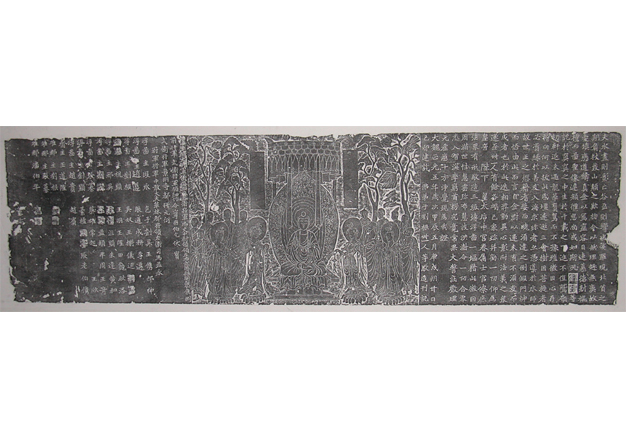

Mr. Wang Jingquan, vice director and researcher of the Exhibition Department of Henan Museum.Devoted to the research on the archaeology and art of Buddhism,he has made an impressive achievement by publishing over 10 monographs and 20+ academic papers on the core journals in China.